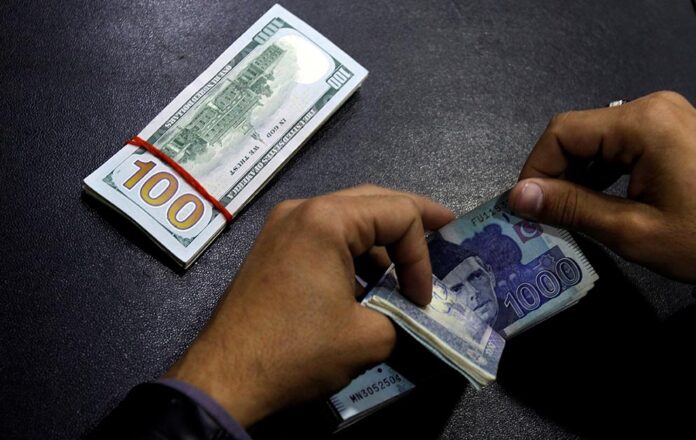When the results of the last market treasury bills (T-bills) auction were released on September 6, it seemed the market expected policy rate, which was at 22%, to be hiked up by 200 basis points (bps) to 24%. This was because the cut-off yield — the highest interest accepted — for the three-month T-bill had already gone up to 24.49%.
However, when the State Bank of Pakistan’s Monetary Policy Committee (MPC) met on September 14, it decided to maintain the policy rate at 22%. Subsequently, in the latest T-bills auction held on September 20, the cut-off yield for the three-month tenor decreased to 22.78%
Why did the yields go down? Was the SBP now ahead of the curve, with the market now aligning itself after receiving a “clear” message from the central bank? Had the finance ministry pushed for a rate hike in the last auction? (After all, while the SBP issues tenders for the T-bills auction, the ministry decides the cut-off). Profit explains.
What is a T-bill?
T-bills are short-term government securities, with tenures not exceeding a year, that are issued by the government and distributed in the primary and secondary markets by the SBP. These highly liquid government securities have sovereign guarantees and a fixed rate of return, which is also known as a yield. T-bills are a tool for raising short-term cash by governments.
Banks are allowed to hold this security in an Investor Portfolio of Securities account for their customers. Investors can buy these securities in a competitive auction in the secondary market, or a non-competitive auction in the primary market.
On auction day, primary dealers, such as banks and brokerage houses, offer bids for T-bills with a certain yield. This yield is determined by policy rates, market sentiment and future expectations. A certain cut-off yield is announced that accepts all bids at that rate or below. The dealer pays the SBP a discounted amount for the bill, which is returned in full at maturity factoring in the yield of the T-bills. So, for example, a T-bill’s maturity value is Rs1,000, yield is 22% per annum, and maturity is three months. You can buy the T-bill at a discounted rate, say Rs950. At the end of three months, you will get Rs1,000 plus the yield which is the interest you have earned.
In general, commercial banks extend financing to the government by buying its debt securities, including T-bills and Pakistan Investment Bonds. This has become more relevant with the passing of the IMF-approved State Bank of Pakistan Act 2022, which prohibits the federal government from borrowing from the central bank. Section 9C of the Act states, “The Bank shall not extend any direct credits to or guarantee any obligations of the Government, or any government-owned entity or any other public entity.” Instead, they can now borrow at the market rate from commercial banks.
The auctions
On September 6, the SBP invited tenders for all three tenures to raise Rs1.95 trillion for debt maturity of Rs2.05 trillion. It received bids totalling Rs1.80 trillion. The cutoff yields for the three-month, six-month and 12-month T-bills were 24.49%, 24.78%, and 25.06%, respectively. Meanwhile, the weighted average yields were 23.39%, 24.78% and 25.05% respectively. The government managed to raise Rs1.33 trillion in that auction.

However, the September 14 auction saw huge participation with bids totalling Rs4.27 trillion. The cut-off yields for the three-month, six-month and 12-month tenures were 22.78%, 22.80%, and 22.90%, respectively, declining by up to 217 bps. Meanwhile, the weighted average yields were 22.75%, 22.80% and 22.85%, respectively. The government managed to raise Rs2.36 trillion against a target of Rs2.25 trillion for debt maturity of Rs2.43 trillion.
Cut-off yields vs. weighted average yields
Analysts polled by Profit before the MPC meeting had predicted the policy rate would be hiked by up to 150 bps. The September 6 auction indicated that the market was expecting a rate hike as well. Since it is the finance ministry that decides the cut-off yields and not the SBP, was the former also pushing for an increase?
That may not necessarily be the case. Topline Securities CEO Mohammad Sohail noted that the finance ministry borrows based on its own funding needs, and not based on market expectations of the policy rate.
The government had set a target of raising Rs1.95 trillion in the September 6 auction, but the SBP only received bids totalling Rs1.80 trillion. Independent economic analyst AAH Soomro pointed out that the government’s financing needs were pressing. “Thus, instead of rejecting [high offers] and [only] accepting low offers, the ministry had to accept to the best extent whatever was available.”
Mustafa Mustansir, director of research and business development at Taurus Securities, explained why the weighted average yields could not be ignored when looking at T-bills auctions. Even if one bid of an overall smaller amount was accepted, the cut-off yield would go up, he pointed out.
As Soomro put it, “Weighted average borrowing cost of the previous auction was 23.4% compared to 24.5% cut-off thus giving the perception that such high rates are acceptable. It was the borrowing target that needed to be met to meet obligations.”
In short, since the government needed to borrow a specific amount, it was forced to accept a higher bid, leading to an increase in the cut-off yield.
During the post-MPC analysts briefing held on the same day, SBP’s Executive Director of Financial Markets and Reserve Management, Muhammad Ali Malik, confirmed as much. “The cut-off yield has to be seen in the broader context … requirements of the government rather than expectations of the market.”
Malik added: “If you look at the Sept 6 auction, the weighted average yield was 23.39% which is much lower than the cut-off yield of 24.49%. The reason the cut-off yield was high was that a small amount of bids were accepted at a higher rate. But the majority of [accepted] bids were within the range [of 22%].”
State Bank gives clear signal
If we compare the weighted average yields from both auction results, they have decreased towards the same ball-park range as the policy rate. The amount offered through bids was also much higher in the second auction. Sohail said there were aggressive buyers in the September 20 auction who got a “clear signal” from the latest monetary policy statement.
When asked if the SBP is leading the market instead of the other way around, Soomro commented, “We can safely assume that SBP is operating independently instead of merely reacting to market sentiments. There is pragmatism and realisation that interest rates are already high enough to contain imbalances.”
Policy rate, inflation and T-bills
During the last fiscal year, economists and the IMF said the central bank was behind the curve in managing inflation. In a staff report following the $3 billion Standby Agreement signed in June, the IMF stated, “Monetary policy fell behind the curve, as price pressures built up to five-decade high inflation and de-anchored expectations. Several pauses in the policy rate tightening cycle and the dramatic increase in the size of the SBP’s open market operations to maintain the policy rate within its corridor resulted in loose monetary policy conditions, at a time when inflation was already on the rise.”
The SBP responded to the IMF’s complaints; shortly before the agreement was signed, the central bank hiked the policy rate to 22% in an emergency meeting. However, it has since maintained the rate, citing a decline in inflation from a record high of 38% in May.
In the latest MPC meeting, the SBP reiterated that inflation is expected to continue declining, in part due to the high-base effect, and will be reduced significantly in the latter half of fiscal year 2024. SBP Governor Jameel Ahmad also said in the analysts’ briefing on September 14 that the monetary policy was tight and in line with the IMF agreement.
Does this mean the SBP is finally ahead of the inflation curve? Mustansir commented that it would be slightly premature to say the central bank was now ahead of the curve. It could only be determined after looking at inflation figures in the coming months as prices of fuel, gas and electricity were expected to rise further. Those increases would affect headline inflation, and also have a lagged effect on core inflation (the latter removes volatile factors when measuring inflation such as food and energy prices), he said.
“We cannot say [SBP is ahead of the curve] until the interest rate aligns somewhat with the inflation rate,” he added. Headline inflation in August was measured at 27.4%.
The central bank governor certainly thinks the State Bank is not behind the curve. At the analysts briefing, Ahmed said the September 6 auction had taken place at a time when uncertainty was prevailing. The exchange rate was volatile, with the rupee freefalling in the open market untill September 4 and the premium between it and the interbank market widening.
“The government has taken a lot of actions since then which has improved the market sentiment. The SBP has reviewed all monetary developments in much more detail,” he added. The governor reiterated during the briefing that the monetary policy was appropriate and tight.
The SBP firmly believes it is ahead of the inflation curve, and the real interest rate — interest rate minus rate of inflation — is positive on a forward-looking basis. With the latest monetary policy committee decision, it has sent a clear message that the interest rate has peaked. And the September 14 T-bills auction shows that the market has aligned itself with the central bank’s stance.


























How come western countries keep interet rates leas than five percent and it cant be done here.
Similarly state bank and ministry of finance acted against nations interest while depreciating rupee.
Both high interest rate and rupee depreciation is against public and nations interest. who so ever is responsible is doing bad.
How come western countries keep interet rates leas than five percent and it cant be done here.
Similarly state bank and ministry of finance acted against nations interest while depreciating rupee.
Both high interest rate and rupee depreciation is against public and nations interest. who so ever is responsible is doing bad.
Finance ministry and state bank should bring interest rates lower than five percent it will move economy reduce debt burden reduce unemployment. Same should be done by appreciating rupee value and should be more strong than indian rupee.